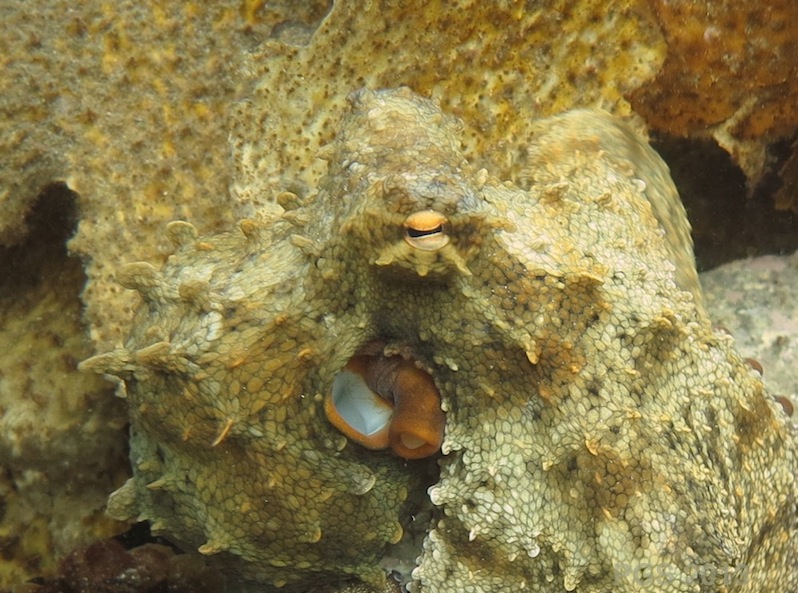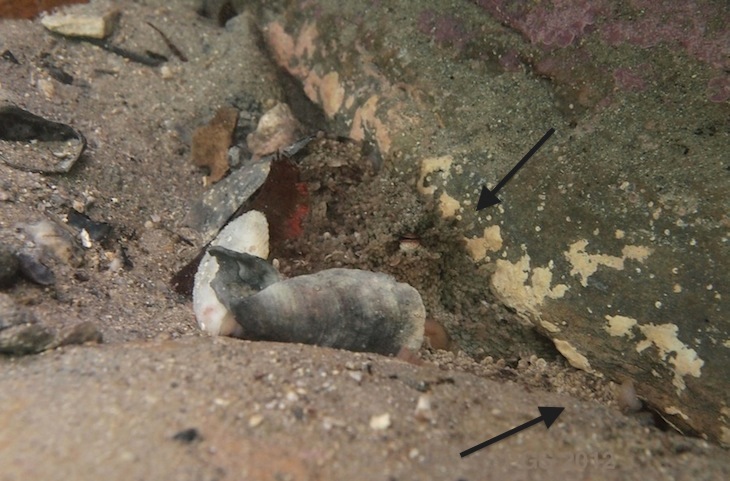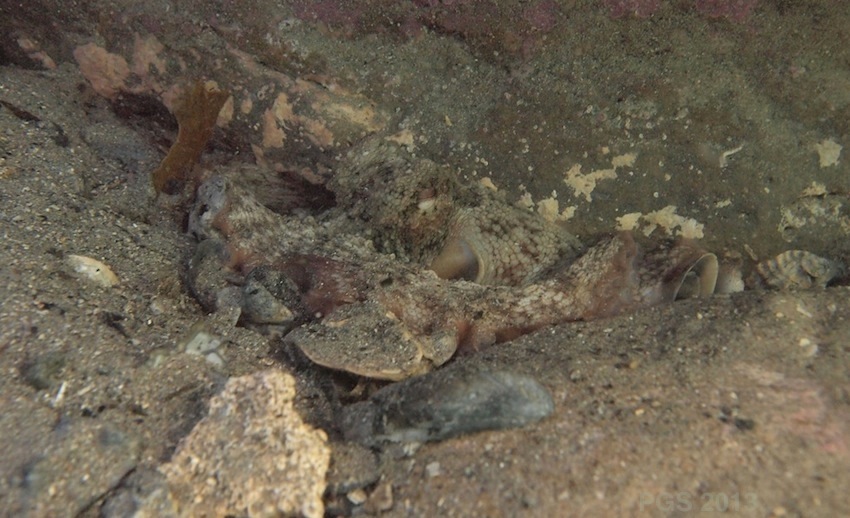21. Trompe l’oeil
Back in January I followed this octopus as it hunted. It explored a rock covered in yellow-green kelp, and as it climbed around, it sometimes produced a perfect match for the colors around it. It was hard to see where seaweed ended and octopus began.
Here is a close-up of the area where the yellows match behind his head.
How do octopuses trick the eye?
One part of what they have to do is produce particular colors. This is done with several layers of specialized cells in their skin. The chromatophores, near the surface, contain sacs of pigment, and the sacs can be expanded or contracted by tiny muscles to reveal or conceal a particular color. The colors of chromatophores vary according to species, but the only available colors are black/brown, red, orange, and yellow. Greens, blues, and violets are produced differently, with the aid of several kinds of reflecting cells that lie deeper in the skin. These cells can refract and scatter light, as well as reflect it straight back. (Here’s a page with a summary of how this works, here’s a more detailed paper, and this new article compares color production in a range of animals.)
So the colors above were probably produced by expanding yellow chromatophores and perhaps using reflecting cells to add some green.
But that is only half the task, and not what I wanted to emphasize. The octopus also has to work out which color to make. And there is the real mystery. Octopuses, it is generally believed, are color-blind. Their eyes are good at detecting brightness, but they have no way to track the hues of the objects around them.
How can you match colors you can’t see? The standard answer is that they use brightness as a clue to color to some extent, and also make use of those tiny mirrors in their skin, the reflecting cells. It’s not necessary to detect and re-make a color if you can just reflect it back.
That is what the books say, but I can’t help thinking there is something missing here. In some of the best cases of camouflage, the octopus’ front side is a good match for the color of what is behind it, and – as far as I can tell – the colors coming in from the front are different from those behind. Then the match to what is behind the octopus can’t be produced by merely reflecting incoming light. That, at least, is how it seems, but it’s hard to tell from casual observation what the light coming from the front is really like.
Here is the same octopus a minute or two before, feeling about under a rock.
(One more shot of him is here.)
Watching it roam around I was reminded of another very camouflaged octopus, of the same species, from a year or so back. This one was uncanny.
I used a photo of his eye in an earlier post. What is especially impressive is the way the arm at the lower right – if you can’t see any octopus there, look for the sucker on the far right– matches the sand-colored rock in front of him, while his head matches the green-grey rock behind.
That shot shows also the role played by adjusting the skin texture, as well as color. Below is another of the same octopus: more conspicuous now, especially as you can see more suckers, and the skin texture also has less going on. (And one more of him, with no camo at all.)
I said above: there seems to be something missing from the explanation about how they do all this. The most interesting speculation floating around is that some light-sensing goes on in the cephalopod skin. In 2010 a paper (by Lydia Mäthger, Steven Roberts, and Roger Hanlon) came out reporting the expression of a gene for a light-sensing chemical in the skin of a cuttlefish. Even if it is being used to sense light, this alone would not solve the color-detection problem, as the light-sensing chemical (the photopigment) in the skin is chemically the same as the single one in their eyes, and the whole point here is that you need at least two kinds of photopigment to discriminate colors. But it might be a piece of the puzzle. I’ve seen a few follow-up references that suggest something like this might be going on in octopuses, too.
_____________
Postscripts. Some beautiful images of starfish skin have just appeared on WetPixel, here, taken by Russian photographer Alexander Semenov.
And again on vision, Deep Sea News has just put up a good short article about the eye of the Giant Squid.






